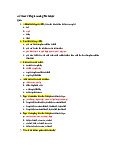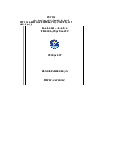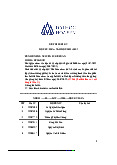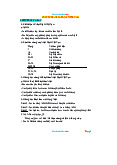



















Preview text:
AVTC6_Unit 7_Diagrams TABLE OF CONTENTS 1 Unit 7: FULL ESSA Y: DIA GRAMS 2 I.PRE- WRITING 3 A.Definition 3 B.Strategy to analyze a diagram. 5 C.Structur e of a diagram essay 6 D.Useful language 6 E.Analyze a sample diagram 8 F. Brainstorm ideas 10 II.WHILE- WRITING 12 III.POST -WRITING 13 ANSWER KEY 18
[FOR INTERNAL USE AT VAN LANG UNIVERSITY ONLY] - page 1
Unit 7: DIAGRAMS (FULL ESSAY) I.PRE-WRITING A. Definition 1. Characteristics of diagrams
A diagram is a series of pictures which show the stages of how something is made or how something works.
All diagram tasks require the use of language showing the purpose and order of stages. 2. Types of diagrams:
The IELTS Writing Task 1 – Diagram type can be either a linear process or a cyclical process, including:
- a process showing how something is made, i.e. a man-made process (e.g., the process of making paper);
- a flow chart showing the step-by-step analysis of a process; often used by
organizations (e.g., procedure for hiring new staff);
- a cycle showing a series of events that move from one stage to the next,
going round and round in a never-ending circle, i.e. a natural process (e.g., the life cycle of a bee);
- an object (e.g., cutting tools in the Stone Age).
(Source: Biggerton. P. (2010). The Complete Guide to Task 1 Writing. Godiva Books.)
1. Linear process (flow-chart, man-made process) - having a starting point and an ending point.
The diagram below shows the stages and equipment used in the cement-making
process, and how cement is used to produce concrete for building purpose.
Summarize the information by selecting and reporting the main features, and make comparison where relevant.
(Source: Cambridge University Press. (2011). Cambridge IELTS 8.)
2. Cyclical process (cycle, natural process) - a series of steps happen again and again in the same order.
The diagram shows the life cycle of the honey bee.
Summarize the information by selecting and reporting the main features, and make comparison where relevant.
(Source: IELTS Writing task 1. IELTS Simon. Retrieved 3 May 2022, from https://www.ielts-simon.com/)
B. Strategy to analyze a diagram. Step 1 Identify the type of Linear or cyclical diagram diagram Tense (mostly simple present) Identify significant Step 2 Active or passive voice grammatical Sequencing language points Identify the number of steps/ Step 3 Analyze the diagram stages in the diagram
Choose a suitable starting point Write at least 150 words. Report ALL the steps/stages Requirements Use academic language Don't give your opinion
C. Structure of a diagram essay a. Introduction
Introduce the type of information shown in the
diagram (Paraphrase the question). b. Overview
State the number of steps/ stages, including the starting and ending point. c. Body 1
Describe the first group of steps/ stages d. Body 2
Describe the second group of steps/ stage
* If you do not give any overview, you will get below band 5 for the Task Achievement criterion. D. Useful language 1. Introduction The pictures illustrate how + N + is/ are PP. The illustration shows
the steps involved in + doing something. The diagram highlights
the various stages in the process/ cycle of + something The depicts
the steps by which + S + is/ are + PP (+ over a infographic period of + number + years). The flowchart details
the different steps needed + to V (produce/ make) +
from + (number) original ingredients. Examples:
The pictures show the steps involved in producing
concrete. The diagram highlights the steps by which concrete is produced.
The diagram details the different steps needed to produce concrete from the original ingredients. 2. Overview - The process begins with + N/ N phrase and ends with + N/ N phrase .
- It is clear that there are + ( ,
3 5, 10, etc.)+ stages in the production of +
Noun, starting with + and ending with + N/ N phrase
- It is clear that there are + ( ,
3 5, 10, etc.)+ stages in the complete cycle of + Noun, beginning with + N/ Noun phrase and ending with + N/ Noun phrase .
- S + is a fairly uncomplicated/ complex process in which there are + number +
stages from commencement to finalization, starting with + Noun phrase.
- S + consists of/ comprises/ is made up of/ has + several parts/ three main
parts. (=> This structure is used to describe objects.) Examples: - It is clear that cement,
there are five stages in the production of the beginning with
input of raw materials and ending with bags of the finished product. To produce
concrete, four different materials are mixed together.
(Source: The Complete Guide to Task 1 Writing; ieltssimon.com)
3. Body paragraphs: Sequencing language: The first stage:
- The process commences with + N phrase/ The process starts when + clause.
- In the initial phase of the process, S + be + PP, after which + S + be + PP.
- The first/ next stage of + O + involves + N phrase. Examples:
- The process commences with an inspection of the merchandise.
- In the initial phase of the process, water from the ocean is pumped into a
filter, after which filter backwash is discarded back into the sea.
- The first stage of making drinking water involves extracting it from the sea. The subsequent stages:
- In the subsequent stage, clause.
- Meanwhile/ At the same time, clause. - Following this, clause.
- After/ Once + S + PP, clause. - As a result, clause.
- The process + comes to an end with + N phrase. Examples:
- In the subsequent stage, the newly freshened water undergoes treatment with
lime, chlorine, and fluoride in order to make it more suitable to drink.
- Once the tea has been packed into boxes, the boxes are then loaded onto the lorry.
- The procedure comes to an end with the water being stored and sent to a water supply system. E. Analyze a sample diagram
The diagram below shows how coffee is produced and prepared for sale in supermarkets and shops.
Summarize the information by selecting and reporting the main features and make
comparisons where relevant.
Task 1. Work in pairs. Look at the process above and answer the questions.
1. What is the type of this diagram? (Is it a man-made or natural process? Is it linear or cyclical)? 2. What is it about?
3. How many steps are there in this process? Are there any stages that happen simultaneously?
4. What is the first and last step of the process?
5. What are the raw materials? What is produced at the end of the process?
6. Should you report all the steps? Can the stages be combined?
7. How do you organize the body paragraphs?
8. What does each stage of the process do?
9. What are the relationships between each stage? 10. What tenses are required?
11. Do you use passive or active voice in the writing or both?
12. Do you need to compare or talk about trends?
Task 2. Complete the outline for the above diagram based on your answers in Task 1. Introduction
The process of making and the preparation for . Overview
There are steps - starting from and ending at . Body 1
1st step: coffee beans in the fields.
beans before being put in , -->
the beans into coffee granules. Body 2 6th stage: with hot water
the resulting mixture is strained
the mixture , passed through the grinder it in a vacuum
water evaporates, coffee granules
these granules into coffee jars




